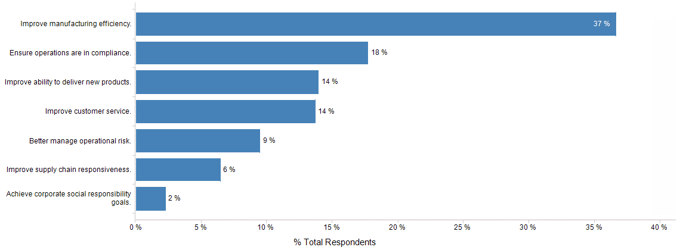Efficient and effective business processes are a pre-requisite to Operational Excellence (OpEx), but are only part of the story. We at LNS Research have written extensively about the need for a holistic approach to OpEx that encompasses alignment of the right combination of People, Process, and Technology capabilities. This is a well-accepted paradigm and reminds us to keep the big picture in mind in continuous improvement efforts.
Lately, my coverage of the Environmental, Health, and Safety (EHS) space on this blog has focused mostly on technology and people aspects. Here we’ll zero in on the process part of the equation.
The Importance of Business Process Efficiency and Effectiveness
Our surveys of manufacturing and industrial organizations show that improving efficiency is the top operational objective (see chart). Along with ensuring compliance and the ability to deliver new products to the market, companies are clearly focused on business process improvement. This is reflected in the large-scale implementation of Operational Excellence continuous improvement strategies such as Lean.
(Click here to see the image in full size)
What’s a business process? A good practical definition is an activity or set of activities that will accomplish a specific organizational goal. Business process improvement efforts are focused on systematically improving process efficiency and effectiveness. The cost of sub-optimal business processes can be great in terms of time, cost, and risk.
Let’s consider EHS management through a business process lens and look at some potential impacts of inefficient, ineffective processes:
- Increased cost of compliance
- Risk of non-compliance
- Adverse events impacting people, assets, and the environment
- Impact on productivity and profitability from production interruptions
- Delayed product innovation cycles and time-to-market
- Poorly managed risks: operational, financial and strategic
- Loss of reputation and brand value through adverse events
- Lack of business continuity
Though this is just a partial list, it shows that the potential impacts range from tactical to strategic.
3 Strategies for EHS Business Process Improvement
Here are three strategies to use for successful process improvement initiatives:
1. Take an End-to-End Value Chain Approach
EHS requirements and activities are pervasive across an industrial enterprise. They are not isolated in one function or work group. This makes the concept of Value Chain the ideal starting point for EHS process improvement initiatives. This concept is based on a process view, in which an organization that produces goods or services is seen a system, made up of subsystems each with inputs, transformation processes, and outputs.
For a typical manufacturer, the primary value chain activities will encompass R&D, procurement, operations, sales and marketing, supply chain, and service. Secondary activities such as HR, Finance, and EHS management support these core activities. Beyond the four walls of the enterprise, the extended value chain encompasses interactions with external business partners.
The cross-cutting nature of EHS requirements and risks means that they often span organizational and physical boundaries. For example, decisions made in R&D on what materials and components will be used in a new product may have major implications across the lifecycle: product compliance requirements in sourcing, worker health, and safety in manufacturing, product hazard communication, waste management, and so forth.
This means that EHS process improvement efforts shouldn’t be focused on optimization of a task or within a silo, rather on synchronization with cross-functional end-to-end processes. Such a collaborative value chain approach will help link formerly disconnected processes and reduce risk and cost.
2. Apply a Maturity Model to Guide Improvement Efforts
Maturity models are a practical resource to guide process improvement efforts by providing a way to assess the “as-is” state and compare it to best practices. The LNS Research Operational Excellence Maturity Model is a framework for describing the stages organizations typically go through in their evolution towards being leaders that influence the market by driving standards and expectations. We define five levels of maturity, ranging from Ad Hoc to Innovation Leaders.
We’ve applied this maturity model to describe the steps organizations take in their EHS journey with business process excellence being a primary dimension. Less mature organizations have processes that are informal, ad hoc, and disconnected. On the other end of the spectrum, Innovation Leaders have processes that are globally integrated and harmonized, and compliant with the latest standards and emerging capabilities.
Use of such a maturity model will provide a roadmap to assess current process maturity, identify gaps, and develop improvement plans. Your organization probably has a standard methodology for this as part of its Lean or other continuous improvement programs.
3. Think Big, But Start Small
Focus and start small, while thinking big and long-term. Identify a specific problem to be solved, and a targeted approach to solving it through process improvement. The odds of success will be much greater than trying to “boil the ocean.” This will help open the door to the next process improvement project after early wins with incremental value are shown.
Advancing your process improvement initiative will require justification. Long-term success depends on gaining executive support, with an improvement and technology roadmap backed by a business case. View the business case as a journey starting with focused projects showing value early, and building to a master business case for more strategic improvement. The idea is to drive adoption, realize value, and communicate it. Then rinse and repeat.
To wrap up, improvement of business process efficiency and effectiveness is core to continuous improvement initiatives that are widely deployed in industry. Clearly, process improvement is a fundamental aspect of Operational Excellence as part of an integrated “People, Process, Technology” approach. Given that EHS management is, or at least should be, an enterprise- and supply chain-spanning activity, it makes sense to apply value chain thinking to increase the maturity of EHS processes. And most importantly to do so cross-functionally to synchronize EHS with core end-to-end core business processes.
![[eBook] Operationalizing EHS Management: Bridge the Gap from Strategy to Execution](https://no-cache.hubspot.com/cta/default/136847/5f2ba619-ded8-4529-ab6c-1ca61d66dd10.png)